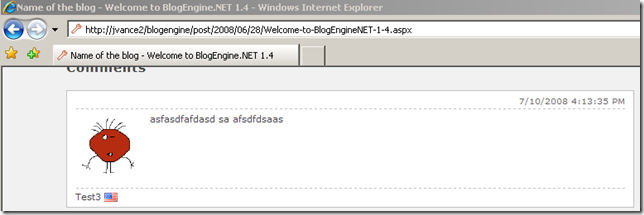Jarrett's Tech Blog - Browsing BlogEngine.NET
-
Comments Security Hole in BlogEngine.NET 1.4
I found a hole in BlogEngine.NET that allows anyone to delete and approve comments.
UPDATE 7/11: Fixed in 1.4.0.12Verify the Hole
- Add a test comment to your blog

- Refresh the blog posting to retrieve latest source
- View source of blog posting
- Find guid of comment to delete (see line 103 below)
<div id="id_9c2b8578-1dde-421e-94ff-5ea7e0d82012" class="comment"> <p class="date">7/10/2008 4:13:35 PM</p> <p class="gravatar"><img src="http://www.gravatar.com/avatar/b642b4217b34b1e8d3bd915fc65c4452.jpg?s=80&d=..." alt="Test3" /></p> <p class="content">asfasdfafdasd sa afsdfdsaas </p> <p class="author"> Test3 <img src="/blogengine/pics/flags/us.png" class="flag" alt="us" /> </p> </div>- Request a POST to BlogPostUrl.aspx?deletecomment=guid

- Refresh the page and notice comment is deleted
Patch the Hole
You can patch the hole by updating the Page_Load event in the CommentView.ascx.cs file by checking for an authenticated user (lines 117,118, & 127)
protected void Page_Load(object sender, EventArgs e) { if (Post == null) Response.Redirect(Utils.RelativeWebRoot); if (!Page.IsPostBack && !Page.IsCallback) { if (Page.User.Identity.IsAuthenticated) { if (Request.QueryString["deletecomment"] != null) DeleteComment(); if (!string.IsNullOrEmpty(Request.QueryString["approvecomment"])) ApproveComment(); if (!string.IsNullOrEmpty(Request.QueryString["approveallcomments"])) ApproveAllComments(); } string path = Utils.RelativeWebRoot + "themes/" + BlogSettings.Instance.Theme + "/CommentView.ascx";Repeat the steps given above to verify that the hole has been patched.
In the process of adding OpenID support to the comment system in BlogEngine.NET I found myself deep in a rabbit hole of refactoring. This comment security issue is just one of the things I've found during my journey. I've reported the issue on the BlogEngine.NET Issue Tracker. I think it is important to point out that the patch above is just a quick fix. The proper solution is to put authorization checks in the business layer (the BlogEngine.Core.Post business object in this case).
-
Add OpenID to BlogEngine.NET 1.4 Part 1
Update : there is no Part 2 as I switched to AtomSite for my blog engine.
Here is a guide on how to add OpenID support to BlogEngine.NET 1.4. This first blog post will detail how to use an OpenID account to login as an existing blog user via impersonation. I've used Andrew's blog post How to add OpenID support to BlogEngine.NET as a starting place.
Pros
- Quick, minimum changes required
- Retains support of blogging tools (such as Live Writer)
- Easy to understand and backwards compatible
Cons
- Not "true" OpenID integration
- Accounts are maintained separately
- Impersonation file is required
Step 1: Download latest release of dotnetopenid library
Step 2: Place DotNetOpenId.dll into Bin folder (if compiling BlogEngine.Web then add reference to project)
Step 3: Update Login.aspx page
- Add
<%@ Register Assembly="DotNetOpenId" Namespace="DotNetOpenId.RelyingParty" TagPrefix="RP" %>
- Replace
<asp:Login ID="Login1" runat="server" class="loginbox" />
with
<RP:OpenIdLogin ID="OpenIdLogin1" runat="server" onloggedin="OpenIdLogin1_LoggedIn" />
Step 4: Update Login.aspx.cs code behind file
- Replace
protected void Page_Load(object sender, EventArgs e) { if (Page.User.Identity.IsAuthenticated) { changepassword1.Visible = true; changepassword1.ContinueButtonClick += new EventHandler(changepassword1_ContinueButtonClick); lsLogout.Visible = true; Login1.Visible = false; Page.Title += Resources.labels.changePassword; } else { Login1.LoggedIn += new EventHandler(Login1_LoggedIn); Login1.FindControl("username").Focus(); } }with
protected void Page_Load(object sender, EventArgs e) { if (Page.User.Identity.IsAuthenticated) { changepassword1.Visible = true; changepassword1.ContinueButtonClick += new EventHandler(changepassword1_ContinueButtonClick); lsLogout.Visible = true; OpenIdLogin1.Visible = false; Page.Title += Resources.labels.changePassword; } }- Replace
void Login1_LoggedIn(object sender, EventArgs e) { if (!Roles.IsUserInRole(Login1.UserName, BlogEngine.Core.BlogSettings.Instance.AdministratorRole)) Response.Redirect(BlogEngine.Core.Utils.RelativeWebRoot, true); }with
protected void OpenIdLogin1_LoggedIn(object sender, DotNetOpenId.RelyingParty.OpenIdEventArgs e) { //don't allow login control to login, we will do that manually e.Cancel = true; //get impersonated user string user = Impersonation.Impersonate(e.ClaimedIdentifier); if (!Roles.IsUserInRole(user, BlogEngine.Core.BlogSettings.Instance.AdministratorRole)) Response.Redirect(BlogEngine.Core.Utils.RelativeWebRoot, true); else FormsAuthentication.RedirectFromLoginPage(user, OpenIdLogin1.RememberMe); }Step 5: Add Impersonation.xml file to App_Data folder
<impersonation> <impersonate> <id>http://jarrettv.myopenid.com/</id> <user>Jarrett</user> </impersonate> </impersonation>Step 6: Add Impersonation.cs to BlogEngineCore project and compile
using System; using System.Linq; using System.Xml.Linq; using System.Web; using System.Web.Hosting; namespace BlogEngine.Core { public class Impersonation { public static string Impersonate(string id) { string user = id; string path = BlogSettings.Instance.StorageLocation + "impersonation.xml"; if (!VirtualPathUtility.IsAppRelative(path)) throw new ArgumentException("xmlFileName must be app-relative"); string fullyQualifiedPath = VirtualPathUtility.Combine (VirtualPathUtility.AppendTrailingSlash (HttpRuntime.AppDomainAppVirtualPath), path); string actualPath = HostingEnvironment.MapPath(fullyQualifiedPath); XDocument xDoc = XDocument.Load(actualPath); user = xDoc.Element("impersonation").Elements("impersonate") .Where(x => x.Element("id").Value == id).Select(x => x.Element("user")).Single().Value; return user; } } }Step 7: Deploy following changed files
- Login.aspx
- Login.aspx.cs
- \Bin\BlogEngine.Core.dll
- \Bin\DotNetOpenId.dll
- \App_Data\Impersonation.xml

In the next part, I will add OpenID support to the comment system.